1.3 How to Understand Research Results
descriptive statistics Statistics that describe the results of a research study in a concise fashion.
frequency distribution A depiction, in a table or figure, of the number of participants (frequency) receiving each score for a variable.
Once we have completed an experiment, we need to understand our results and to describe them concisely so that others can understand them. To do this, we need to use statistics. There are two types of statistics—
Descriptive Statistics
In an experiment, the data set consists of the measured scores on the dependent variable for the sample of participants. A listing of this set of scores, or any set of numbers, is referred to as a distribution of scores, or a distribution of numbers. To describe such distributions in a concise summary manner, we use two types of descriptive statistics: measures of central tendency and measures of variability.
median The score positioned in the middle of a distribution of scores when all of the scores are arranged from lowest to highest.
mode The most frequently occurring score in a distribution of scores.
Measures of central tendency. The measures of central tendency define a “typical” score for a distribution of scores. There are three measures of central tendency (three ways to define the “typical” score)—mean, median, and mode. The first, the mean, is one that you are already familiar with from our earlier discussion of the regression toward the mean phenomenon. Remember, the mean is the numerical average for a distribution of scores. To compute the mean, you merely add up all of the scores and divide by the number of scores. A second measure of central tendency is the median—the score positioned in the middle of the distribution of scores when all of the scores are listed from the lowest to the highest. If there is an odd number of scores, the median is the middle score. If there is an even number of scores, the median is the halfway point between the two center scores. The final measure of central tendency, the mode, is the most frequently occurring score in a distribution of scores. Sometimes there are two or more scores that occur most frequently. In these cases, the distribution has multiple modes. Now let’s consider a small set of scores to see how these measures are computed.
Let’s imagine a class with five students who just took an exam. That gives us a distribution of five test scores: 70, 80, 80, 85, and 85. First, let’s compute the mean or average score. The sum of all five scores is 400. Now divide 400 by 5, and you get the mean, 80. What’s the median? It’s the middle score when the scores are arranged in ascending order. Because there is an odd number of scores (5), it’s the third score—
Of the three measures of central tendency, the mean is the one that is most commonly used. This is mainly because it is used to analyze the data in many inferential statistical tests. The mean can be distorted, however, by a small set of unusually high or low scores. In this case, the median, which is not distorted by such scores, should be used. To understand how atypical scores can distort the mean, let’s consider changing one score in our sample distribution of five scores. Change 70 to 20. Now, the mean is 70 (350/5). The median remains 80, however; it hasn’t changed. This is because the median is only a positional score. The mean is distorted because it has to average in the value of any unusual scores.
range The difference between the highest and lowest scores in a distribution of scores.
Measures of variability. In addition to knowing the typical score for a distribution, you need to determine the variability between the scores. For example, two distributions might have the same mean, but one distribution might have little variability between scores and the other, considerable variability between scores. So how is such variability measured? There are two measures of variability—
standard deviation The average extent that the scores vary from the mean for a distribution of scores.
The measure of variability used most often is the standard deviation. In general terms, the standard deviation is the average extent that the scores vary from the mean of the distribution. In other words, how spread out are the scores? If the scores do not vary much from the mean, the standard deviation will be small. If they vary a lot from the mean, the standard deviation will be larger. In our example of five test scores with a mean of 80, the scores (70, 80, 80, 85, and 85) didn’t vary much from this mean, therefore the standard deviation would not be very large. However, if the scores had been 20, 40, 80, 120, and 140, the mean would still be 80; but the scores vary more from the mean, therefore the standard deviation would be much larger.
The standard deviation and the various other descriptive statistics that we have discussed are summarized in Table 1.4. Review this table to make sure you understand each statistic. The standard deviation is especially relevant to the normal distribution, or bell curve. We will see in Chapter 6, on thinking and intelligence, that intelligence test scores are actually determined with respect to standard deviation units in the normal distribution. Next we will consider the normal distribution and the two types of skewed frequency distributions.
| Descriptive Statistic | Explanation of Statistic |
|---|---|
| Correlation coefficient | A number between –1.0 and +1.0 whose sign indicates the type (+ = positive and – = negative) and whose absolute value (0 to 1.0) indicates the strength of the relationship between two variables |
| Mean | Numerical average for a distribution of scores |
| Median | Middle score in a distribution of scores when all scores are arranged in order from lowest to highest |
| Mode | Most frequently occurring score or scores in a distribution of scores |
| Range | Difference between highest and lowest scores in a distribution of scores |
| Standard deviation | Average extent to which the scores vary from the mean for a distribution of scores |
Frequency Distributions
normal distribution A frequency distribution that is shaped like a bell. About 68% of the scores fall within 1 standard deviation of the mean, about 95% within 2 standard deviations of the mean, and over 99% within 3 standard deviations of the mean.
A frequency distribution organizes the data in a score distribution so that we know the frequency of each score. It tells us how often each score occurred. These frequencies can be presented in a table or visually in a figure. We’ll consider visual depictions. For many human traits (such as height, weight, and intelligence), the frequency distribution takes on the shape of a bell curve. For example, the heights of American adult men are distributed in a bell-
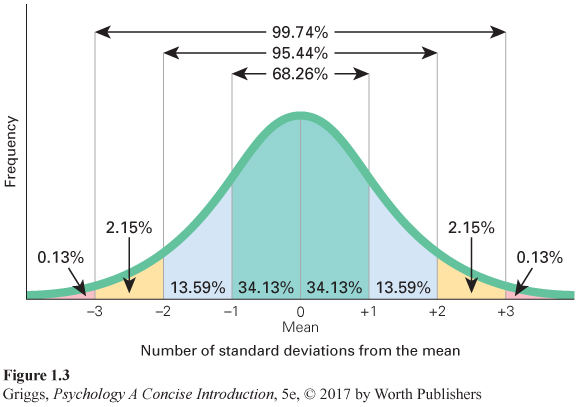
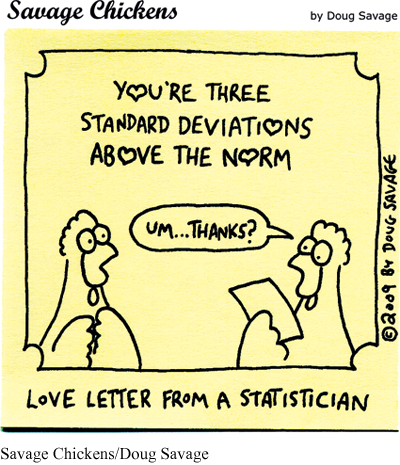
Normal distributions. There are two main aspects of a normal distribution. First, the mean, the median, and the mode are all equal because the normal distribution is symmetric about its center. You do not have to worry about which measure of central tendency to use because all of them are equal. The same number of scores fall below the center point as above it. Second, the percentage of scores falling within a certain number of standard deviations of the mean is set. About 68% of the scores fall within 1 standard deviation of the mean; about 95% within 2 standard deviations of the mean; and over 99% within 3 standard deviations of the mean. So what does this mean for the normal distribution of the heights of American adult men with a mean of 5 feet 10 inches? First, we have to know the standard deviation for this distribution. It is 3 inches. Thus, 68% of the heights of American men fall between 5 feet 7 inches (5 feet 10 inches – 3 inches) and 6 feet 1 inches (5 feet 10 inches + 3 inches), 95% between 5 feet 4 inches (5 feet 10 inches – 6 inches) and 6 feet 4 inches (5 feet 10 inches + 6 inches), and 99% between 5 feet 1 inch (5 feet 10 inches – 9 inches) and 6 feet 7 inches (5 feet 10 inches + 9 inches).
These percentages falling within a certain number of standard deviations are what give the normal distribution its bell shape. The percentages hold regardless of the size of the standard deviation for a normal distribution. Figure 1.4 shows two normal distributions with the same mean but different standard deviations. Both have bell shapes, but the distribution with the smaller standard deviation (A) is taller. As the size of the standard deviation increases, the bell shape becomes shorter and wider (like B).
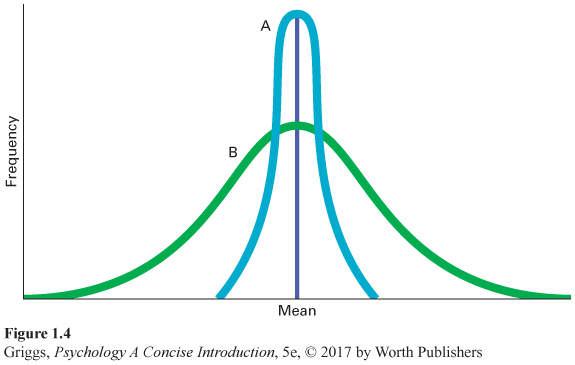
percentile rank The percentage of scores below a specific score in a distribution of scores.
The percentages of scores and the number of standard deviations from the mean always have the same relationship in a normal distribution. This allows you to compute percentile ranks for scores. A percentile rank is the percentage of scores below a specific score in a distribution of scores. If you know how many standard deviation units a specific score is above or below the mean in a normal distribution, you can compute that score’s percentile rank. For example, the percentile rank of a score that is 1 standard deviation above the mean is roughly 84%. Remember, a normal distribution is symmetric about the mean so that 50% of the scores are above the mean and 50% are below the mean. This means that the percentile rank of a score that is 1 standard deviation above the mean is greater than 50% (the percent below the mean) + 34% (the percent of scores from the mean to +1 standard deviation).
Now I’ll let you try to compute a percentile rank. What is the percentile rank for a score that is 1 standard deviation below the mean? Remember that it is the percentage of the scores below that score. Look at Figure 1.3. What percentage of the scores is less than a score that is 1 standard deviation below the mean? The answer is about 16%. You can never have a percentile rank of 100% because you cannot outscore yourself, but you can have a percentile rank of 0% if you have the lowest score in the distribution. The scores on intelligence tests and the SAT are based on normal distributions, so percentile ranks can be calculated for these scores. We will return to the normal distribution when we discuss intelligence test scores in Chapter 6.
right-
left-
Skewed distributions. In addition to the normal distribution, two other types of frequency distributions are important. They are called skewed distributions, which are frequency distributions that are asymmetric in shape. The two major types of skewed distributions are illustrated in Figure 1.5. A right-
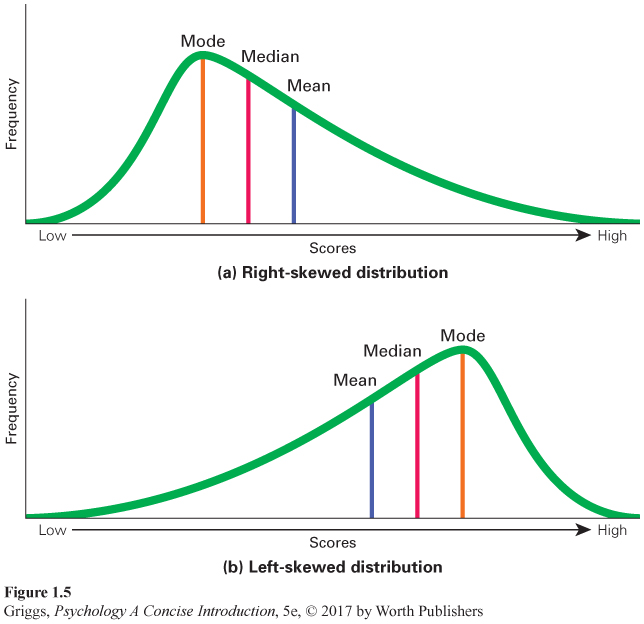
Now that we have defined right-
The distribution of people’s incomes is a good example of a right-
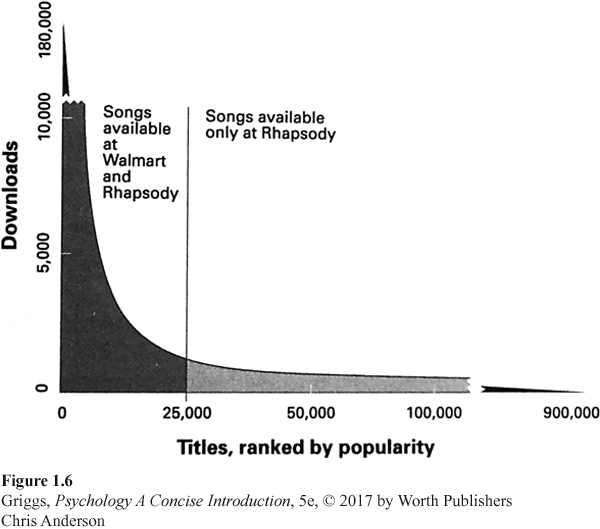
Because unusually high or low scores distort a mean, such distortion occurs for the means of skewed distributions. The mean for a right-
Skewed distributions are also important to understand because various aspects of everyday life, such as medical trends (mortality rates for various diseases), are often skewed. Let’s consider a famous example of the importance of understanding skewed distributions (Gould, 1985). Stephen Jay Gould, a noted Harvard scientist, died of cancer in 2002. However, this was 20 years after he was diagnosed with abdominal mesothelioma cancer and told that this type of cancer had “a median mortality rate of 8 months after diagnosis.” Most people would think that they would only have about 8 months to live if given this median statistic. However, Gould realized that his expected chances depended upon the type of frequency distribution for the deaths from this disease. Because the statistic is reported as a median rather than a mean, the distribution is skewed. Now, if you were Gould, which type of skewed distribution would you want—
Gould wrote a famous article called “The Median Isn’t the Message,” in which he argued that his knowledge of statistics saved him from the erroneous conclusion that he would necessarily be dead in 8 months. In confronting his illness, Gould was thinking like a scientist. Such thinking provided him and the many readers of his article with a better understanding of a very difficult medical situation. Thinking like a scientist allows all of us to gain a better understanding of ourselves, others, and the world we all inhabit. Such thinking, along with the accompanying research, has enabled psychological scientists to gain a much better understanding of human behavior and mental processing. We describe the basic findings of this research in the remainder of the book. You will benefit not only from learning about these findings but also from thinking more like a scientist in your daily life.
Section Summary
To understand research findings, psychologists use statistics—
The standard deviation is especially relevant to the normal (bell-
3
Question 1.8
.
Explain what measures of central tendency and measures of variability tell us about a distribution of scores.
Measures of central tendency tell us what a “typical” score is for the distribution of scores. The three central tendency measures give us different definitions of “typical.” The mean is the average score; the median is the middle score when all of the scores are ordered by value; and the mode is the most frequently occurring score. Measures of variability tell us how much the scores vary from one another, the variability between scores. The range is the difference between the highest and lowest scores, and the standard deviation is the average extent that the scores vary from the mean for the set of scores.
Question 1.9
.
Explain why the normal distribution has a bell shape.
It has a bell shape because the scores are distributed symmetrically about the mean with the majority of the scores (about 68%) close to the mean (from –1 standard deviation to +1 standard deviation). As the scores diverge from the mean, they become symmetrically less frequent, giving the distribution the shape of a bell.
Question 1.10
.
Explain the relationship between the mean and median in a right-
In a right-